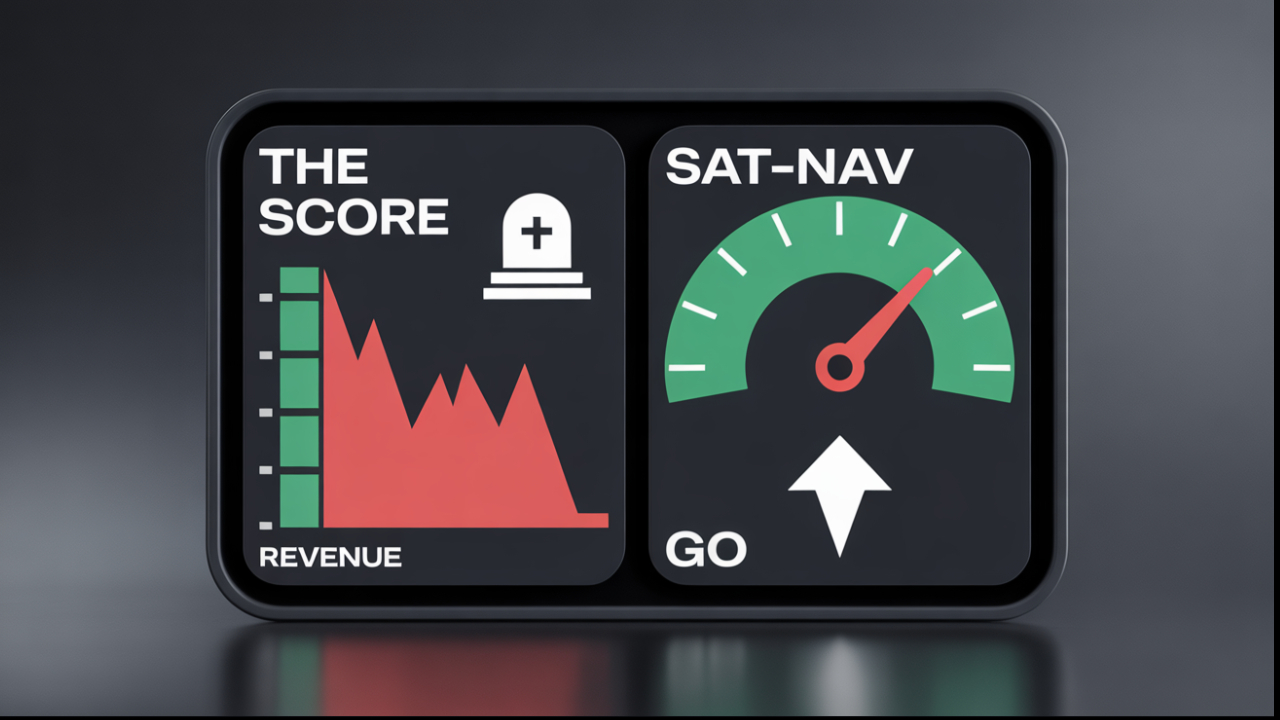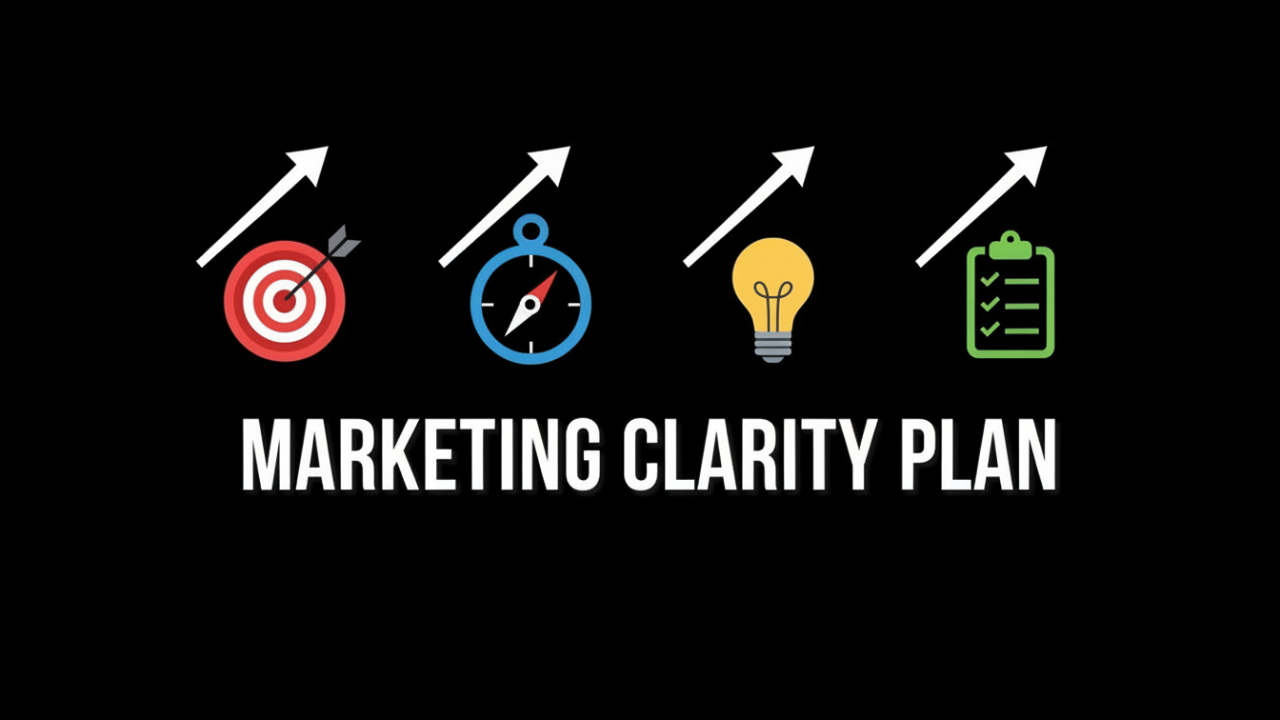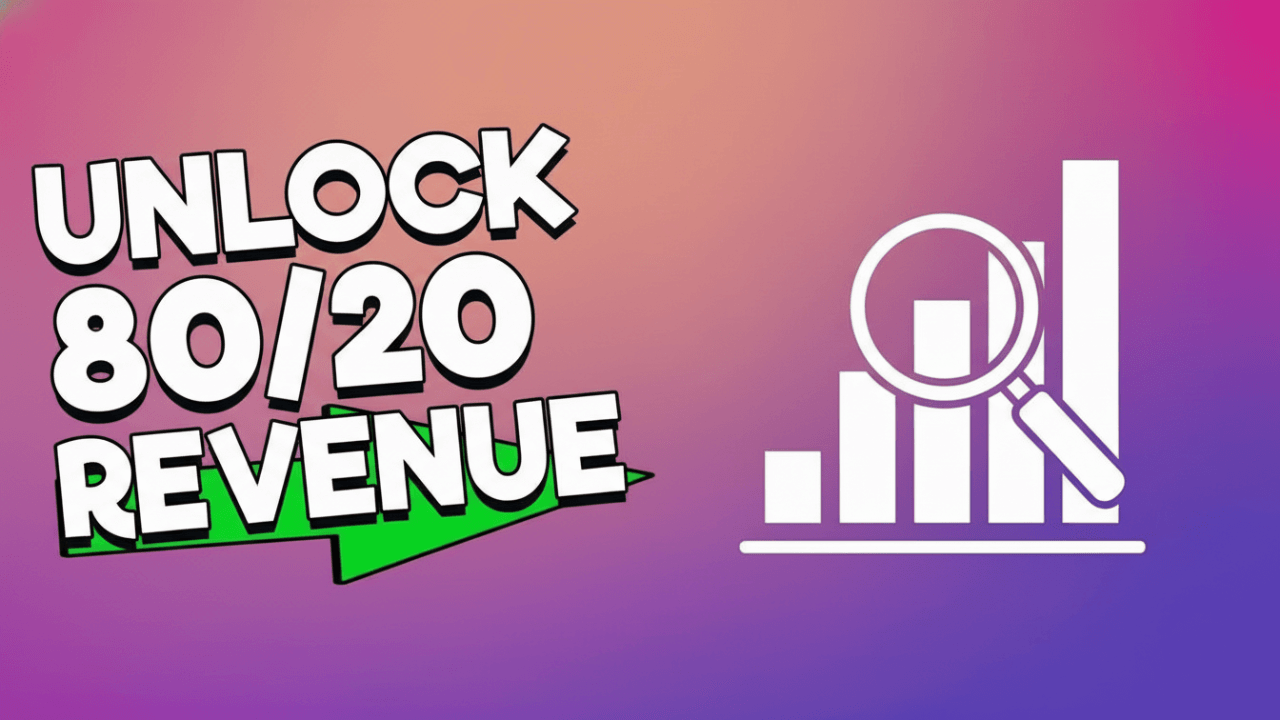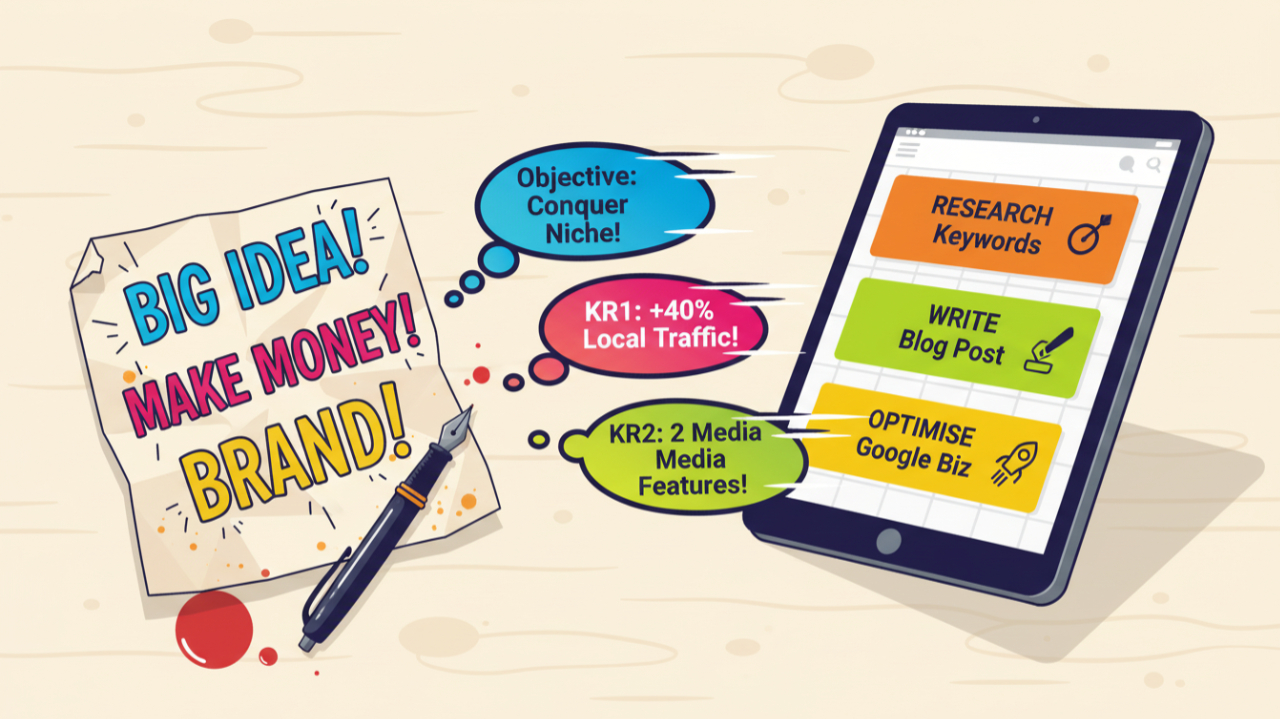Stop Writing To-Do Lists Disguised as Goals: A Business Owner's Guide to OKRs That Actually Work
Right, let's talk about goals. Not the vague, new year’s resolution kind that fade by February, but the kind that actually get your team pulling in the same direction and, you know, get stuff done. If you’re running a small business, you’ve probably heard the acronym OKR thrown around. Objectives and Key Results. It’s the shiny framework a lot of the big tech companies use, and it’s meant to be this magic bullet for growth and focus.
The problem is, for every team it works for, there seem to be three others where it becomes a soul-crushing admin exercise. A list of things that either never get looked at or, worse, make everyone feel like they’re failing. I’ve seen it happen more times than I can count. Teams spend a week writing these beautiful, elaborate OKRs, and by week three of the quarter, they’re gathering digital dust in a forgotten spreadsheet.
So, what’s the crack?
To be honest, it’s usually because people are taught the what but not the why or the how. They get the definition but miss the spirit of it entirely. This isn’t going to be another textbook definition post. This is a practical, demystified guide to writing OKRs that don’t suck. We’ll look at where it goes wrong, how to build a good one from the ground up, and I’ll give you a step-by-step process you can actually use with your team. Let’s turn this from a dreaded chore into your company’s secret weapon.
Why Most OKRs Fail (And Teams Lose Motivation)
Before we build, we need to understand why the foundations so often crumble. The biggest reason OKRs fail is a misunderstanding of their purpose. They are not a to-do list. They are not a performance review tool for individuals. They are a framework for alignment and for measuring what matters.
Most failed OKRs fall into a few common traps. See if any of these sound familiar.
First, there’s the
Vagueness Trap. The objective is something fluffy and inspirational like “Improve Our Brand Presence.” It sounds great in a meeting, but what does it
actually mean? How do you know when you’ve done it? Your marketing person thinks it means more social media posts, your sales guy thinks it means getting into a trade magazine, and you were thinking about a new logo. Everyone is busy, but nobody is aligned. It’s a recipe for frustration.
Then you have the
Overload Trap. This is a classic for ambitious business owners. You have so many great ideas, so you set ten different objectives for the quarter. You want to launch a new product, enter a new market, overhaul customer service, redesign the website, and improve team culture. The result? Your team’s focus is spread so thin it’s transparent. They’re jumping between a dozen different priorities, making an inch of progress in a dozen directions instead of a mile of progress in one. It leads to burnout, not breakthroughs.
Finally, there’s the
Task Trap. This is where your Key Results are just a list of things you were going to do anyway. The Objective is “Launch the New Website,” and the Key Results are “Write the copy,” “Design the homepage,” and “Test the contact form.” You’ve just created a glorified project plan. The problem is, you can tick all those boxes and still have a website that doesn’t achieve a single business goal. You did the work, but you didn’t get the outcome.
Want a quick diagnostic for your current goals? Ask yourself and your team these two simple questions:
- Can you put a number on this? If the answer for a Key Result is no, it’s probably a task, not a measure of success.
- Would a new starter understand what success looks like from this sentence alone? If it’s full of internal jargon or vague language, it’s not clear enough.
When OKRs are vague, overwhelming, or just a list of tasks, they become demotivating. Your team starts to see them as just another piece of corporate theatre. And that’s when you lose the most valuable thing they’re supposed to create: genuine, shared focus.
The Anatomy of a Motivating OKR
So, what does a good one look like? It’s actually beautifully simple. It has two parts:
- The Objective (O): This is the what. It’s the ambitious, qualitative, and inspirational goal you’re aiming for. It should be memorable and get people a little bit excited. It sets the destination.
- The Key Results (KRs): This is the how. These are the quantitative, measurable outcomes that prove you’ve achieved your objective. They are not tasks. They are results. They are the signposts that tell you you’re on the right road to your destination.
Think of it like planning a big family trip from London to the Scottish Highlands.
Your
Objective might be:
Have an unforgettable, adventure-filled family holiday. It’s inspirational, clear, and sets the tone.
Your
Key Results would not be “Book the hotels,” “Pack the car,” or “Buy snacks.” Those are tasks. Your Key Results would be the proof that the holiday was a success:
- KR1: Hike at least 3 Munros together.
- KR2: Discover and photograph 5 different lochs.
- KR3: Achieve a family consensus rating of 8/10 or higher for the trip.
See the difference? The KRs are the evidence of success. They are measurable, specific, and directly tied to the outcome you want. You could do all the tasks (book hotels, pack the car) and still have a miserable trip where everyone argued. Focusing on the outcomes forces you to think about what truly defines success.
The principles behind a great OKR are:
- Clarity: It’s written in plain English. No jargon.
- Measurability: The Key Results have numbers in them. Always.
- Deadlines: OKRs are almost always set for a quarter. This creates urgency and focus.
- Inspiration: The Objective should feel like a challenge, something that gets the team to stretch a little.
The Antidote: What Exactly Is a Vision-To-Action Session?
So, how do you fix this? The answer isn’t another meeting. In fact, it’s the opposite. It’s a dedicated, focused workshop designed to make all your other meetings exponentially more productive. It’s a "Vision-To-Action Session."
Think of it as a strategic reset button. It’s a structured, facilitated session where you pull key team members away from the daily grind for a few hours to bridge the gap between the high-level company vision and the nitty-gritty of operational execution. It’s about taking that beautiful strategy document off the digital shelf, dusting it off, and making it real, tangible, and actionable for everyone in the room.
The purpose is threefold:
- Clarify: To ensure every single person has the same, unambiguous understanding of the company’s vision and, more importantly, the top strategic priorities for the coming period (e.g., the next 90 days).
- Align: To get everyone to agree on how their team’s work and individual responsibilities directly contribute to achieving those priorities. This is where you break down silos.
- Action: To collaboratively define the specific, measurable outcomes, key projects, and clear action steps that will move the company toward its goals.
A Vision-To-Action Session fundamentally shifts your meeting culture. Your regular management meetings stop being reactive forums for discussing problems and become proactive check-ins on a pre-agreed strategic plan. The conversation changes from “What should we do?” to “How are we progressing on the plan we all created and committed to?” It transforms the dynamic from a meandering debate into a focused engine of progress.
Good vs. Bad OKRs: Examples Side by Side
Sometimes the best way to understand this is to see it in action. Here are a few common scenarios for a small business, showing the difference between a weak, task-based OKR and a strong, outcome-focused one.
The "Bad" OKR is just a project plan. You can do all those things and have the launch be a complete flop. The "Good" OKR focuses on why you're launching a new website in the first place. You want it to generate business. The key results are undeniable proof of whether it's working. That’s the shift in thinking you need to make.
A Step-by-Step Process for Writing OKRs That Work
Ready to try it yourself? Don't just call a meeting and expect magic to happen. Follow a process.
Step 1: Start with “Why” and Involve Your Team
Before writing an objective, get the right people in a room. This shouldn’t be a top-down directive. Start the session with a big question: “What is the single most important thing we need to achieve this quarter?” Let people discuss. Your job is to guide the conversation from broad ideas towards a specific area of focus.
Step 2: Craft Clear, Inspiring Objectives
Turn your focus into an Objective. Use action-oriented language. Instead of "Better Marketing," try "Establish Our Brand as the Go-To Expert in Our Niche." It should be a short, memorable sentence that sets a clear direction.
Step 3: Write Measurable, Outcome-Focused Key Results
For your Objective, ask: “If we achieved this, what would be different? What numbers would have changed?” Push past the easy answers, which are usually tasks. KRs must have a number. They measure outcomes, not output.
Step 4: Limit the Number for Focus
A company your size should have no more than 3 to 5 objectives per quarter. Each objective should have 2 to 4 key results. It will feel painful, but focus is the whole point.
Step 5: Review Together and Refine
Read your drafted OKRs out loud. Do they make sense? Are they ambitious but not impossible? Refine the language until everyone is nodding. Everyone should leave knowing exactly what the priorities are for the next three months.
Plug and Play Worksheet: Your Next OKR Session
Here’s a simple template you can use. Before the meeting, send it out and ask everyone to come with one or two ideas for a potential company objective.
Our OKR Planning Template
Date: [Date of meeting]
Quarter: [e.g., Q2 2024]
Objective 1: [What is the ambitious, qualitative goal? Make it inspiring!]
Why does this matter? [A brief sentence on the strategic importance.]
- Key Result 1.1: [Measure of outcome] | From [X] to [Y]
- Key Result 1.2: [Measure of outcome] | From [X] to [Y]
- Key Result 1.3: [Measure of outcome] | From [X] to [Y]
Objective 2: [What is the next ambitious, qualitative goal?]
Why does this matter? [A brief sentence on the strategic importance.]
- Key Result 2.1: [Measure of outcome] | From [X] to [Y]
- Key Result 2.2: [Measure of outcome] | From [X] to [Y]
- Key Result 2.3: [Measure of outcome] | From [X] to [Y]
(Continue for up to 3-5 objectives total)
Use this structure on a whiteboard or in a shared document during your meeting. It forces you to think in the right way, separating the inspiring goal from the hard evidence of the key results.
Troubleshooting: Avoiding Pitfalls and Bad Habits
Even with the best intentions, you can drift off course. Here’s a quick checklist of warning signs to look out for during your weekly check-ins.
Warning Sign: A Key Result is stuck at 0% or 100% for weeks.
- What it means: It’s probably a binary task (e.g., "Launch feature"). Once it's launched, it's 100%.
- How to fix: Ask, "What is the intended result of launching that feature?" and rewrite the KR to measure that (e.g., "Achieve 20% user adoption of the new feature within 30 days").
Warning Sign: The team isn’t sure how to measure a Key Result.
- What it means: It’s too vague or you don't have the right data tracking in place.
- How to fix: Refine it immediately. If you can’t measure it, it’s not a Key Result. Find a proxy metric if you have to, but get a number in there.
Warning Sign: The Objective sounds like a department name, like "Marketing" or "Sales."
- What it means: It’s not an objective, it’s just a statement of function. It has no direction.
- How to fix: Ask what the most important outcome for that department is this quarter and make that the objective.
Warning Sign: People refer to the OKRs as "your" goals, not "our" goals.
- What it means: There’s a lack of buy-in. They feel like the goals were handed down from on high.
- How to fix: This is a cultural issue. In the next planning session, ensure you spend more time on the "why" and actively solicit input from all levels of the team.
Don't be afraid to adjust a Key Result mid-quarter if you realise it was poorly written or is measuring the wrong thing. The map is not the territory. The goal is the outcome, not sticking religiously to a flawed plan.
Key Takeaways: Turning Vision To Action with Strong OKRs
Running a business is hard. It’s easy to get caught in the whirlwind of daily demands and end the quarter feeling busy but unsure if you moved the business forward. That’s the problem good OKRs solve.
They bridge your big vision with the daily actions of your team. By focusing on a few critical outcomes, making them measurable, and aligning everyone, you create clarity and momentum. You replace the chaos of "everything is important" with the power of "this is what matters right now." It’s not about more work. It’s about more impactful work.
It takes practice, and your first few attempts might be a bit clumsy. That's fine. The process of discussing, debating, and defining what success looks like is valuable in itself. Stick with it, and OKRs can transform how your team operates, moving you from a group of people completing tasks to a unified force driving real, measurable change.
Our
Vision-To-Action Programme is designed to embed this exact approach, transforming strategy into concrete, motivating OKRs and KPIs that teams buy into and deliver on. If you want your goals to move from PowerPoint to real-world results, discover how the programme can accelerate your vision today.
Additional Resources:
For further material on related topics, consider exploring the following:
Ready to Break Free From the Fog of Daily Chaos?
Your vision is too important to let it slip away. Don’t stay stuck, watching your strategy gather dust on the whiteboard while urgent tasks take over. If you’re serious about transforming your business vision into purpose-driven action and real results, let’s talk.
Take the first step:
Book a no-obligation, honest conversation with Adam at New Way Growth. No sales pitches, just a genuine chat about your goals and the obstacles holding you back.
Reclaim your team’s momentum, energy, and confidence.
Contact us
now and let’s turn your business strategy into unstoppable progress.
Phone: 0330 311 2820
We look forward to helping you discover your unique path to growth, strategies that fit you - not the other way round.
Pay It Forward! Sharing Is Caring!












